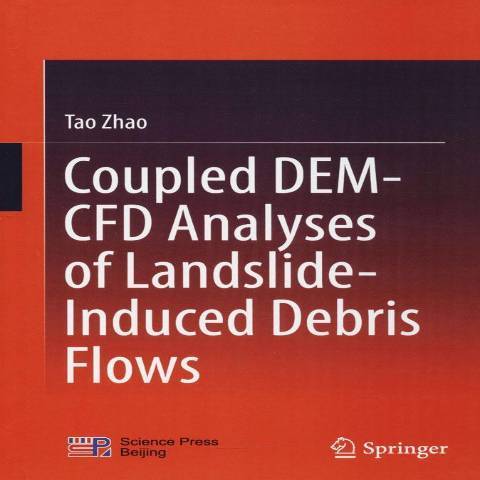《基於流固耦合模型的土石流運動機理分析(英文版) [Coupled DEM-CFD Analyses of Landslide-Induced Debris Flows]》是2017年科學出版社出版的圖書。
基本介紹
- 中文名:基於流固耦合模型的土石流運動機理分析(英文版) [Coupled DEM-CFD Analyses of Landslide-Induced Debris Flows]
- 作者:趙濤
- 出版時間:2017年11月
- 出版社:科學出版社
- ISBN:9787030526304
- 開本:16 開
- 裝幀:平裝
內容簡介,圖書目錄,
內容簡介
This book reflects the latest research results iii computer modelling of landslide-induced debris flows. The book establishes an understancling of the initiation and propagation mechanisms oflandslides by means ot'numerical simulations, so that mitigation strategies to reduce the long-term losses from landslide hazards can be devised.
In this context, the book employs the Discrete Element Method (DEM) and Computational Fluid Dynamics(CFD)to investigate the mechanical and hydraulic behaviour of granular materials involved in landslides - an aproach that yields meaningful insights into the flow mechanisms, concerning e.g. the mobilization of sediments, the generation and dissipation of excess pore water pressures, and the evolution of effective stresses. As such, the book provides valuable intormation, useful methods and robust numerical tools that can be successfully applied in the field of debris flow research.
圖書目錄
1 Introduction to LandsLides
1.1 Background
1.2 Terrestrial Landslides
1.2.1 Classification and Characteristics
1,2.2 Major Research on Terrestrial Landslides
1.3 Submerged Landslides
1.3.1 Classification and Characteristics
1.3.2 Major Research on Submerged Landslides
1.4 Model Testing-Granular Column Collapse
1.5 Numerical Investigations
1.5.1 The Finite Element Method
1.5.2 The Smoothed Particle Hydrodynamics
1.5.3 The Discrete Element Method
1.5.4 The DEM-CFD Coupling Method
2 Introduction to Discrete Element Method
2.1 The Discrete Element Method
2.1.1 Particle Motion
2.1.2 The Particle-Particle Contact Model
2,1.3 The Calculation of Stress in the DEM
2.1.4 Coordination Number
2.2 Model Validation
2.2.1 Input Parameters of the DEM Model
2.2.2 Determination of Numerical Time Step
2.2.3 Numerical Simulation of Triaxial Tests
2.2.4 Material Angle of Repose
2.3 Conclusions
3 Investigation of Dry Granular Flows
3.1 The Granular Column Collapse Model
3.2 Dimensional Analysis
3.3 Numerical Simulations
3.3.1 Deformation of the Granular Assembly
3.3.2 Influence of Initial Column Aspect Ratio
3.3.3 Influence of Model Size Ratio
3.3.4 Influence of Column Characteristic Strain
3.3.5 Infiuence of Material Internal Friction Anglr
3.4 Mechanical Analyses
3.4.1 Evolution of Granular Velocity
3.4.2 Granular Energy
3.4.3 Linear Momentum
3.4.4 Flux of Kinetic Energy
3.4.5 Distribution of Kinetic Energy and Linear Momentum
3.4.6 Evolution of Force Chains
3.4.7 Distribution of Stress
3.4.8 Distribution of Coordination Number
3.4.9 Destination of Surface Grains
3.4.10 Influence of Air Viscous Force
3.5 Conclusions
4 Introduction to the DEM-CFD Coupling Model
4.1 Fluid-Solid Interaction
4.2 Governing Equations of Fluid Flow
4.2.1 Fluid Mass Conservation Law
4.2.2 Fluid Momentum Conservation Law
4.3 The Viscous Shear Stress
4.3.1 Laminar Flow Regime
4.3.2 Turbulent Flow Regime,
4.3.3 Near-Wall Treatment
4.3.4 Initial Conditions
4.4 The MPI Implementation and Data Exchange
4.5 Fluid Flow Through a Porous Soil Sample
4.5.1 Analytical Solution of Soil Permeability
4.5.2 Numerical Model Configuration
4.5.3 Laminar Flow
4.5.4 Turbulent Flow
4.6 Numerical lnvestigation of Granular Sedimentation
4.6.1 The Settling of a Single Particle
4.6.2 Batch Granular Sedimentation
4.7 Conclusions
……
5 Investigation of Submerged Debris Flows
6 Conclusions and Recommendations for Future Work
Appendix A: Summary of the Selected Landslides
Appendix B: Calculation of Porosity
Appendix C: Input Parameters for Simulations
References

